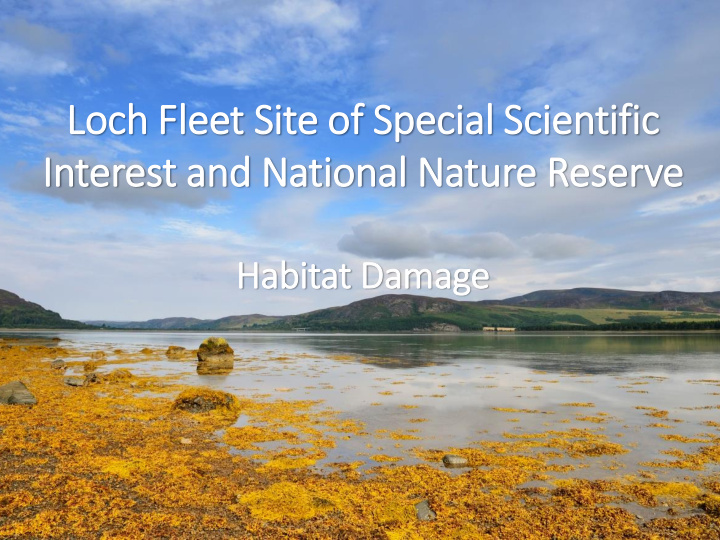



Loch Fleet Site of f Special Scientific In Interest and National Nature Reserve Habitat Damage
About Loch Fleet National Nature Reserve • Owned by Sutherland Estates • Managed in partnership between Scottish Natural Heritage (SNH), Scottish Wildlife Trust (SWT) and Sutherland Estates • Approximately 12,000 visitors per year, but increasing. • No permanent staff on the reserve • Site management carried out by SNH, SWT and team of volunteers
Internationally and Nationally Important Wildlife and Habitats • Dornoch Firth and Loch Fleet Special Protection Area (SPA) (European designation) • Dornoch Firth and Loch Fleet RAMSAR • Loch Fleet Site of Special Scientific Interest (SSSI) • Loch Fleet National Nature Reserve (NNR) • Seal Haul-out Site - Section 117 of the Marine (Scotland) Act 2010 • Loch Fleet and Dornoch Firth and Cuthill Sands Nature Conservation Order (NCO)
So what does that mean? • S ite of Special Scientific Interest Operations Requiring Consent (ORCs) – Certain activities require consent from SNH before they can take place; AND requires landowner or occupiers permission. • Special Protection Area (SPA) – SNH required to consider impacts on SPA before SSSI consent it can be granted.
Main Issues at Loch Fleet Drones Off road vehicles Breaches of Nature Conservation Order Fly tipping and dumping
Drones • Increasing frequency of use within site; • Poor practice often reported, although probable under reporting; • Typically relating to seal haul-outs, over wader and waterfowl roosts and osprey nests also reported; • Challenges • Frequently reported after the event, lack of witnesses or being able to identify individuals • Increasing popularity of Loch Fleet due to NC500 • Currently no code for drone use on NNRs
Drones Disturbance over Seal haul-out
Action taken • Considered ‘reckless disturbance’ by WCO. • Owner of the video traced by Police Scotland and WCO visited individual • Video removed from YouTube
Off-road vehicles • Regular occurrence of unauthorised motor vehicle access to site • Use of vehicles requires SSSI consent • Reckless damage and occasional deliberate damage • Typical damage – Vehicle ruts, skidding, wheel spinning, do-nuts – Damage to NNR infrastructure
Signs and control measures are not are always effective deterrent
Free running dogs • Disturbance to waders, waterfowl and seals at haul out locations. • Not compliant with Scottish Outdoor Access Code; • Can be difficult to manage and identify individuals responsible;
Loch Fleet Nature Conservation Order • Prohibits marine invertebrate and shellfish collection and use of vehicle and craft to collect • Signs erected to warn of Nature Conservation Order around reserve – mitigate against ignorance claims – recklessness • Active police support and generally rapid response from local police and occasionally road traffic officers • Typically caution given and told to leave site by police • Residents encouraged to report breaches to Police on 101
Fly-tipping and dumping • Typically household, garden and building waste – Phantom Leylandi dumper! • Potential release of invasive species onto site • Increasing problem of campervan waste disposal • Vigilance around ‘hotspots’ • Signs – promoting responsible behaviour and nearest licenced recycling centre (6 miles away)
What can be done and what works? • Balancing act between promoting outdoor and restricting outdoor access • Don’t delay reporting it! – Encourage reporting of any crime to Police Scotland at the time of the incident • Importance of local community engagement and involvement in sites • Good relationship with Police Scotland, particularly with local officers – Local knowledge is often key!
What can be done and what works? • Education! • Increasing social awareness of wildlife crime • Signs – Temporary signs can be very effective if targeted; – Permanent signs seldom effective eventually ignored. – Help to raise awareness. – Can be required mitigate against ignorance claims – Are occasionally vandalised or simply ‘go -missing ’ • Physical barriers – Vehicle bollards – Gates and fencing
Any Questions
Recommend
More recommend